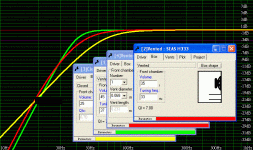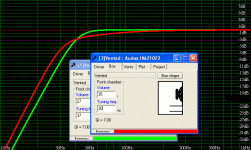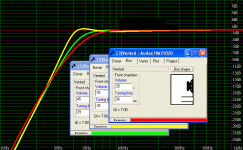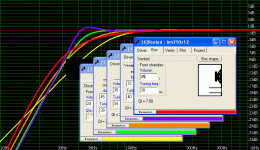I have two unused 32-liter enclosure kits that are originally meant for subwoofers. I intend to build two-way (or three-way) vented-box loudspeakers using these enclosures. Thiele-Small parameters are just right for my enclosures if I choose 8'' Visaton WSP 21 S woofers which have a fairly low resonance frequency of 28 Hz and VAS=80 liters and QTS=0,28.
But what kind of tweeters and crossovers should I put in? If I use a tweeter with a low resonance frequency and a first-order textbook Butterworth crossover, do I have a chance of success without measuring equipment? Or is someone aware of a two-way or three-way design using approximately 32-liter enclosures that I could copy?
But what kind of tweeters and crossovers should I put in? If I use a tweeter with a low resonance frequency and a first-order textbook Butterworth crossover, do I have a chance of success without measuring equipment? Or is someone aware of a two-way or three-way design using approximately 32-liter enclosures that I could copy?
You should copy an available design for 30 to 35 litre cabinets.
Only possible issue is baffle width being different, you can tweak
the inductor value in this design :
http://www.seas.no/kit/Njord.pdf
The crossover is not as simple as it appears......... well it is but....
(I mean it cannot be easily designed on paper)
 sreten.
sreten.
Only possible issue is baffle width being different, you can tweak
the inductor value in this design :
http://www.seas.no/kit/Njord.pdf
The crossover is not as simple as it appears......... well it is but....
(I mean it cannot be easily designed on paper)
I think I have had a look at this Seas Njord design some time ago. It is designed for 40 liters and I have only 32-liter cabinets. According to Thiele-Small equations, my cabinets are somewhat too small for this design.
My baffle width is 340 mm, I think it is wider than the baffle width used in the Njord design. If I chose the Njord, which way should I tweak the inductor value?
My baffle width is 340 mm, I think it is wider than the baffle width used in the Njord design. If I chose the Njord, which way should I tweak the inductor value?
Yes you are right - I thought it was around 35 litres.
Not to worry its all a questoin of bass alignments, but I did
notice the impedance curve is for a sealed box not a reflex.
The inductor should be a little higher in value for a wider baffle,
though if you offset the drivers horizontally it will make less
difference, i.e. if you move the bass unit near one edge I
wouldn't worry about it too much.
But if I was winding the inductor myself I'd add taps for tweaking.
Note that with damping included reflex box volume is ~ +10%.
 sreten.
sreten.
Not to worry its all a questoin of bass alignments, but I did
notice the impedance curve is for a sealed box not a reflex.
The inductor should be a little higher in value for a wider baffle,
though if you offset the drivers horizontally it will make less
difference, i.e. if you move the bass unit near one edge I
wouldn't worry about it too much.
But if I was winding the inductor myself I'd add taps for tweaking.
Note that with damping included reflex box volume is ~ +10%.
Attachments
phibes said:I've built several KLS9 loudspeakers and always worked on a box volume of 2.6 cub ft or around 70-75 litres. Have you heard the KLS9's in a 35 lt enclosure? If so, did you alter the xover at all?
Cheers,
Keith
I'm not saying the KLS9 shouldn't use a 70 litre box simply that
for those concerned with space, or those who already have a
box it can easily be used in other boxes.
If the baffle layout is similar no changes to the crossover are
required. If the baffle is wider, offsetting and perhaps inductor
tweaking would be required.
I've haven't heard a KLS9, nevermind a 35L version.
But like the Njord its a simple design, easily tweaked.
As the original design article says, 75L is really the biggest box
you could put it in, any larger would be pointless. Bass vs space
wise the driver indicates 40 to 50 litres would be the more normal
compromise.
Oops... I clicked on the driver next to it for the above curves,
here are some for the correct Audax driver :
Attachments
If I choose the SEAS Njord design, could a 3.3 mH inductor instead of 2.4 mH one be just appropriate for a wider baffle? I don't want to wind the inductor myself.
How much space should I reserve between the end of the reflex tube and rear wall - is about 20 mm enough? (I have already a 90 mm hole in the baffle and want to use 90 mm reflex tube, so it has to be about 30 cm long and the depth of my cabinets is 34 cm).
Why cannot I design my own first order crossover on paper if I use the at-crossover-frequency-measured driver impedances in the Butterworth equations? If I feel lucky?
BTW, the Audax woofer used in the KLS9 design seems to be discontinued, at least I didn't find it at www.audax.fr.
How much space should I reserve between the end of the reflex tube and rear wall - is about 20 mm enough? (I have already a 90 mm hole in the baffle and want to use 90 mm reflex tube, so it has to be about 30 cm long and the depth of my cabinets is 34 cm).
Why cannot I design my own first order crossover on paper if I use the at-crossover-frequency-measured driver impedances in the Butterworth equations? If I feel lucky?
BTW, the Audax woofer used in the KLS9 design seems to be discontinued, at least I didn't find it at www.audax.fr.
Re KLS 9 enclosure
Hi,
I've built this design three times over the past few years with the original for eldest daughter being closer to 59-60 litres, rather than Keywood's 70-75 litres. Although the second two KLS 9s sounded ok, I always preferred the characteristics of the original. Bass response is a little tighter and defined in my daughters pair of KLS9's. I might try them in a 40 - 50 litre enclosure. Thanks for the graphs.
Cheers,
Keith
Hi,
I've built this design three times over the past few years with the original for eldest daughter being closer to 59-60 litres, rather than Keywood's 70-75 litres. Although the second two KLS 9s sounded ok, I always preferred the characteristics of the original. Bass response is a little tighter and defined in my daughters pair of KLS9's. I might try them in a 40 - 50 litre enclosure. Thanks for the graphs.
Cheers,
Keith
Re Bass Driver for KLS9
Hi Smurfette,
The first pair of KLS9s I built used the HM210Z0 bass driver. That was subsequently discontinued, however, replaced with what they said was an improved, enhanced bass in their new model, the HM210Z12.
Perhaps Sreten can run you a graph optimizing that driver. I didn't notice a lot of difference between the old and new drivers!
Cheers,
Keith
Hi Smurfette,
The first pair of KLS9s I built used the HM210Z0 bass driver. That was subsequently discontinued, however, replaced with what they said was an improved, enhanced bass in their new model, the HM210Z12.
Perhaps Sreten can run you a graph optimizing that driver. I didn't notice a lot of difference between the old and new drivers!
Cheers,
Keith
Re Audax HM210Z12
Hi Smurfette,
On the audax web site go to Produits, Prestige, Boomers/Medium and then Aerogel and you'll find the stats for the HM210Z12.
Cheers,
Keith
[PS] I'd consider upgrading the tweeter in this design as well. Have a look at the TWO25A16.........I've used it in a couple of other designs and it is a better performer than the TWO25MO.
Hi Smurfette,
On the audax web site go to Produits, Prestige, Boomers/Medium and then Aerogel and you'll find the stats for the HM210Z12.
Cheers,
Keith
[PS] I'd consider upgrading the tweeter in this design as well. Have a look at the TWO25A16.........I've used it in a couple of other designs and it is a better performer than the TWO25MO.
Thanks all for advice but now I have a better (?) idea. I'll build two subwoofers using my 32-liter cabinets. Then I shall put the subfoofers under my present 12-liter bass reflex speakers and make use of my unused active Sinus crossover which operates at 80 Hz. But what are the best 8'' woofers for subwoofer purposes?
No, on second thoughts not a good idea...
If I can upgrade the tweeter from TW025M0 to TWO25A16,
why not upgrade to Morel MDT-37? Is there a reason for sticking to strictly Audax tweeters in KLS9?
Another idea: if I tweak the condensator value from 4 uF to 3.3 uF and the inductor value from 1.2 mH to 1 mH, the KLS9 xover cutoff frequency goes up from 3000 Hz to about 3700 Hz which will protect the tweeter better from low freqs at high power levels.
If I can upgrade the tweeter from TW025M0 to TWO25A16,
why not upgrade to Morel MDT-37? Is there a reason for sticking to strictly Audax tweeters in KLS9?
Another idea: if I tweak the condensator value from 4 uF to 3.3 uF and the inductor value from 1.2 mH to 1 mH, the KLS9 xover cutoff frequency goes up from 3000 Hz to about 3700 Hz which will protect the tweeter better from low freqs at high power levels.
Curves for the new driver,
Port tuning of the 72 litre case appears to be critical.
For such a simple design as this the basic principle is :
The bass unit inductor is a compromise between reducing
baffle step and a reasonable crossover frequency, its a fine
line to tread, but high crossover frequencies are out.
Replacing the tweeter is possible but it must be carefully chosen,
its not as case of fitting the best tweeter you can find.
The series resistor needs adjusting to set levels and then the
capacitor possibly adjusting.
Good phase matching is claimed for the original crossover, you
don't want to mess about with this too much in a simple crossover.
You need a tweeter with a very similar impedance curve and
sensitivity if you want to maintain this.
 sreten.
sreten.
Port tuning of the 72 litre case appears to be critical.
For such a simple design as this the basic principle is :
The bass unit inductor is a compromise between reducing
baffle step and a reasonable crossover frequency, its a fine
line to tread, but high crossover frequencies are out.
Replacing the tweeter is possible but it must be carefully chosen,
its not as case of fitting the best tweeter you can find.
The series resistor needs adjusting to set levels and then the
capacitor possibly adjusting.
Good phase matching is claimed for the original crossover, you
don't want to mess about with this too much in a simple crossover.
You need a tweeter with a very similar impedance curve and
sensitivity if you want to maintain this.
Attachments
So called "off axis flaring" is an issue in many designs.
The general priniciple is that the on axis response is
reduced somewhat to compensate, to give a flatter
overall room response.
Dual concentrics suffer less from this problem, as do
tweeters placed in a flare. Lowering the c/o frequency
also tends to reduce the problem.
Simply put - for simple designs it cannot be fixed -
only compensated for - but simple designs can have
other advantages over more complex designs where
off axis flaring is less of a problem.
 sreten.
sreten.
The general priniciple is that the on axis response is
reduced somewhat to compensate, to give a flatter
overall room response.
Dual concentrics suffer less from this problem, as do
tweeters placed in a flare. Lowering the c/o frequency
also tends to reduce the problem.
Simply put - for simple designs it cannot be fixed -
only compensated for - but simple designs can have
other advantages over more complex designs where
off axis flaring is less of a problem.
Hmmm...
I have also another pair of cabinets, with drivers and all, built in the 70's but no longer in working order. These cabinets are huge in volume and the front baffle is quite wide . They were originally used in a closed 4-way system that sounded awesome at the time but the drivers have deteriorated.
Is someone aware of a design, perhaps closed-box 3-way, that I could succesfully copy? Must come down to about 23 Hz since I have quite a few organ records.
The 12'' Peerless XLS woofer would sound nice in these cabinets.
I have also another pair of cabinets, with drivers and all, built in the 70's but no longer in working order. These cabinets are huge in volume and the front baffle is quite wide . They were originally used in a closed 4-way system that sounded awesome at the time but the drivers have deteriorated.
Is someone aware of a design, perhaps closed-box 3-way, that I could succesfully copy? Must come down to about 23 Hz since I have quite a few organ records.
The 12'' Peerless XLS woofer would sound nice in these cabinets.
- Status
- This old topic is closed. If you want to reopen this topic, contact a moderator using the "Report Post" button.
- Home
- Loudspeakers
- Multi-Way
- DIY speakers using 32-liter cabinets



